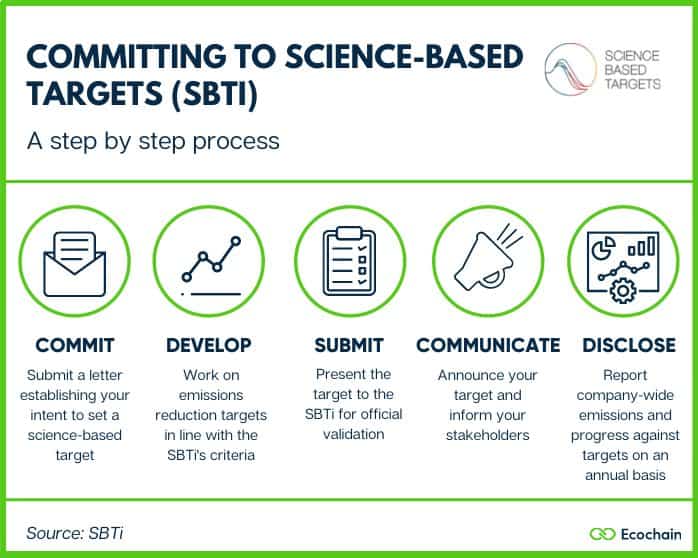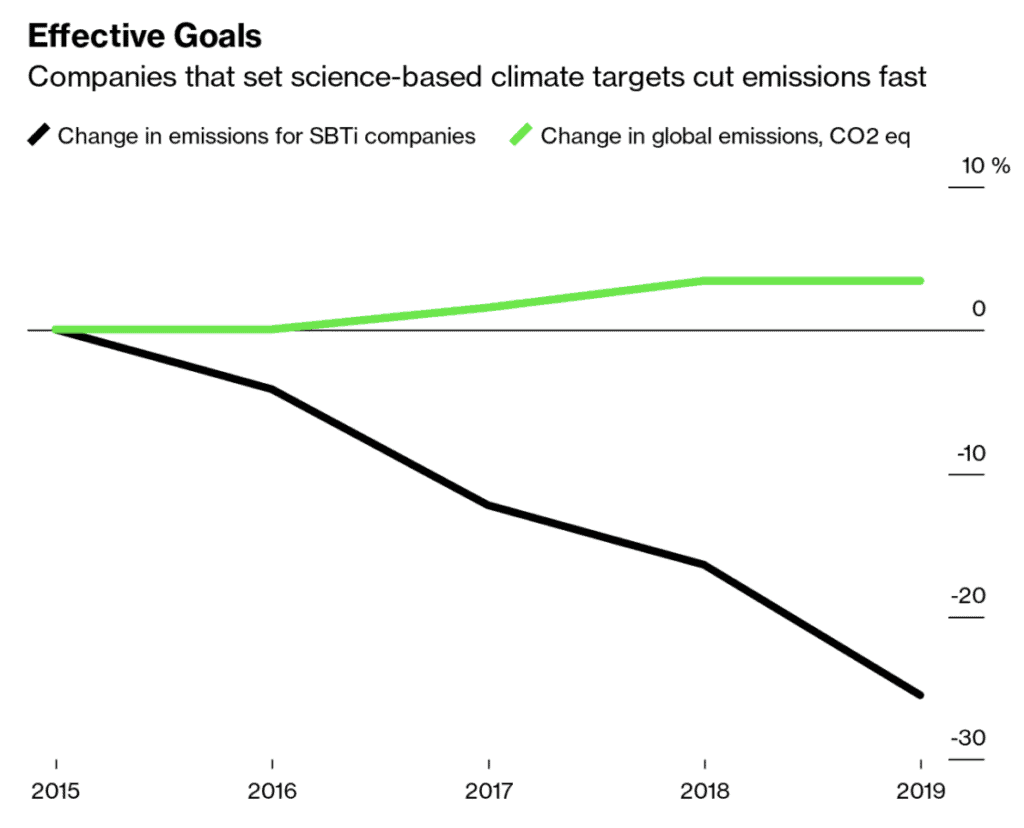Increasing numbers of organizations are embracing reporting and reducing their greenhouse gas emissions (GHG). With that incentive in mind, they often aim to set certain (short-term) goals to achieve.
But what kind of goals should you really set? How can you make sure your targets truly matter in the long run?
You make them science-based.
What are Science-Based Targets?
Short summary: Science-based targets (SBT’s) are organizational targets that show how much- and how quickly organizations need to reduce their Greenhouse Gas emissions. In order to prevent the worst effects of climate change from happening (source: SBTi).
These targets are created by the Science Based Targets initiative (SBTi) and are scientifically confirmed requirements that will set the path for transitioning to a low (preferably zero) carbon economy.
SBT’s are very useful. They provide clear goals that can help all types of organizations to reduce their GHG emissions. But, in a manner that is in line with meeting the goals of the Paris Agreement. To limit global warming to the + 1.5°C– 2°C threshold (above 2°C will have significant negative consequences for our environment).
We need to halve our collective greenhouse gas emissions (GHG) by 2030 and drop them to zero-carbon emissions by 2050.
Science-based targets are organizational targets that show how much and how quickly organizations need to reduce their Greenhouse Gas emissions in order to prevent the worst effects of climate change from happening.

Why should we pay attention to Science-based Targets?
The popularity of SBTi has increased significantly over the years. Right now 2127 companies have committed to science-based targets, including some of the world’s biggest companies, such as Amazon.com Inc., Facebook Inc. And they cut emissions fast (image 1).

*Note: this graph only includes scope 1, and 2 emissions.
Measuring and implementing sustainable change as an organization is increasingly becoming a more important criterion from various stakeholders and investors. If you’re a larger organization, you will have a large impact on the environment because of your size. And will be expected to do something about it.
With these targets, your sustainability efforts are validated, placed in the bigger sustainability picture, and aligned with the CPD (Carbon Disclosure Project) and the GHG Protocol.
These comparable targets will provide many organizations with:
- Reputational and competitive advantages through benchmarking,
- Satisfying investors,
- Putting you ahead of regulations
- Attract talent.

Source: Science Based Targets Initiative – Final column was added by Sustainalize and shows the number prediction by the end of 2020.
Questions to ask yourself when starting with Science-based targets
SBTi analyzed 338 of the companies that effectively set science-based targets and concluded that between 2015 and 2019 these companies reduced their Scope 1 & 2 emissions by 25% (even though global emissions rose by 3.4%). This only shows how science-based targets are a great tangible help in guiding organizations to cut their emissions.
SBTi has excellent technical guidance material on its website. However, you do need to consider a few things before starting with Science-Based targets (SBT’s):
1. Is there leadership buy-in & strategy alignment?
Board approval is a vital success factor. Setting, implementing & monitoring SBT’s is not a small task. Companies need to address this at the core of their strategies in order to ensure these plans are realized and the key business functions support them.
2. What is your baseline GHG (greenhouse gas) performance and what improvement strategies do I have?
You can start with setting targets if you don’t where you’re standing. Progress starts with measuring first. Having a robust baseline GHG measurement (scope 1, 2, and 3) is vital to set proper targets. Furthermore, the main strategic options for sustainable improvement need to be known before you embark on an SBT journey.
Find more information in our 5-step plan on how to move your organization towards carbon neutrality right here.
3. What main target setting options do I have?
SBT’s technical guidance provides a great direction to various types of targets that can be applied. However, the types of business you’re in will determine the type of target you should use. For example, the use of an ‘absolute contraction* target’ does not make sense in a high-growth business.
Moreover, various sectors, such as the power or paper sector, need to use the Sector Decarbonization Approach (SDA). In this approach, companies can determine their targets based on sector-specific business output metrics (e.g. kWh for the power sector).
- SBTi’s guide: target-setting guidance and target examples right here.
- SBTi’s guide: sector-specific requirement for setting science-based targets.
* Contraction: reducing overall emissions of greenhouse gases to a safe level.
4. Who should be involved?
Setting a target is not the hard part. Realizing the target is where most of the effort goes into. Therefore, organizations that embark on this journey should really involve the right business functions in order to ensure success
5. Is my monitoring system A-ok?
Targets cannot be met without a proper measurement system. Companies need to have a robust measurement system in place that provides the proper intelligence to:
(1) Make external disclosures (based on external GHG reporting, e.g. annual reporting or CDP reporting);
(2) Roll out internal performance management to monitor and drive improvement- including accountability;
(3) Perform detailed analytics. E.g. you can create what-if scenarios (what happens if I replace this material with a more sustainable one?) to underpin future business cases and opportunities for further improvement.
SBTi’s new Net-Zero Standard
On the 28th of October, 2021, the Science-based target’s Initiative (SBTi) released its brand new Corporate Net-Zero standard.
The standard provides guidance, criteria, and recommendations to support companies in setting net-zero targets through the SBTi framework. And helps them understand HOW to get to net-zero. It wants companies to:
- Set long-term Science-based targets for completely going to zero emissions (not almost). E.g. 15+ years. They are an ‘end goal’. For example: “[said company] will be net-zero by 2030”.
- Publicly disclose how they finance additional actions beyond their value chain, that contribute to global reductions efforts.
- Unlike the SBT Framework, emissions that aren’t possible to cut – the final 5-10% – can be covered by carbon offsetting. (SBTi calls this carbon neutralization.)
Net-zero targets can be seen as a company’s ultimate goal, SBT’s are the method to achieve it.
The standard standardizes & validates companies’ net-zero targets. And- just as SBT’s- the SBTi will soon be able to verify them too. You can find the full Net-Zero Standard framework here.

Image 4. The key elements of SBTi’s new Net-Zero Standard. Source: SBTi

